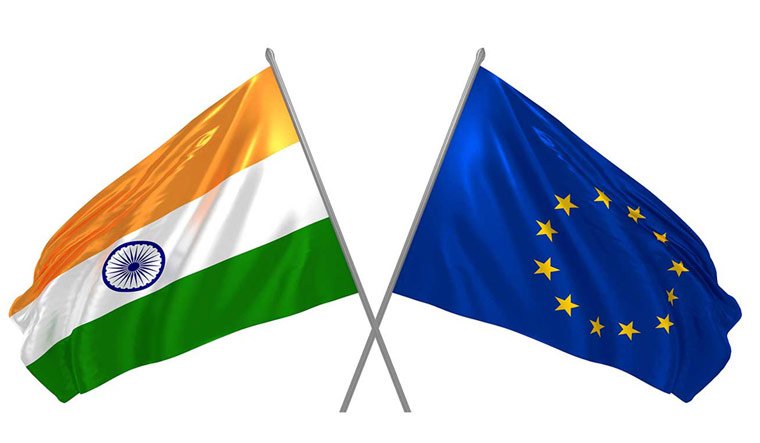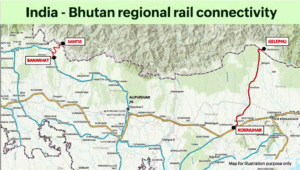
Why in News?
India and the European Union (EU), as major democracies, are under increasing pressure from authoritarian regimes, making their cooperation crucial in addressing global challenges. The India-EU partnership holds immense potential but faces hurdles in delivering consistent outcomes. Strengthening ties is vital for economic growth, technology collaboration, and defending democratic values.
Introduction
India and the European Union share a deep-rooted relationship based on shared democratic values, multilateralism, and economic synergies. As the EU represents the largest economic bloc globally and India is poised to become the third-largest economy by 2030, their partnership is significant for global trade, climate action, and technology innovation. However, geopolitical differences, trade barriers, and structural challenges need resolution to fully realize the potential of this partnership.
Key Aspects of the India-EU Relationship
Shared Values
- Democracy and Multilateralism: Both emphasize promoting democracy, prosperity, and a rules-based international order.
- Economic Synergies:
- India offers a growing market and strategic influence in the Indo-Pacific.
- The EU contributes to India’s economic growth through investments, market access, and advanced technology.
Economic and Trade Relations
Bilateral Trade:
- In 2023-24, India-EU trade in goods reached USD 137.41 billion, making the EU India’s largest trading partner in goods.
- Services trade was valued at USD 51.45 billion.
Foreign Direct Investment (FDI):
- The EU accounts for 17% of India’s total FDI inflow, creating significant employment opportunities.
Sectoral Opportunities:
- Green technology, textiles, and electronics are areas for collaboration and EU investments.
Maritime Security and Defence
Enhanced Security Cooperation:
- The EU’s Enhancing Security Cooperation in and with Asia (ESIWA) aligns with India’s naval expansion in the Indo-Pacific to counter China.
Joint Military Exercises:
- The first India-EU joint naval exercise was conducted in the Gulf of Guinea in 2023.
European Union Overview
- Established: Founded in 1951 with six founding members (Belgium, France, Germany, Italy, Luxembourg, and the Netherlands).
- Current Members: 27 countries; the UK exited in 2020 (Brexit).
- Schengen Area:
- Allows free movement for most EU countries.
- Includes non-EU nations like Iceland, Norway, Switzerland, and Liechtenstein.
- Climate Goals:
- Aim for climate neutrality by 2050 and a 55% reduction in emissions by 2030.
Challenges in India-EU Relations
Geopolitical Differences
- Divergent Priorities:
- India focuses on strategic autonomy and avoids deep alliances.
- The EU emphasizes trade, security, and human rights cooperation.
- Russia-Ukraine Conflict:
- India’s neutral stance contrasts with the EU’s sanctions against Russia.
- China Relations:
- India views China as a strategic competitor, while Europe maintains significant trade ties despite concerns over human rights and economic practices.
Economic and Trade Barriers
- Free Trade Agreement (FTA):
- Negotiations have been delayed since 2007 due to disagreements on intellectual property rights (IPR), labor standards, and environmental policies.
- EU’s Carbon Border Adjustment Mechanism (CBAM):
- Imposes stricter environmental standards, impacting India’s industries.
Defence and Strategic Divergences
- Limited Defence Collaboration:
- India’s reliance on Russian defense systems restricts deeper cooperation with Europe.
- While projects like submarine collaboration with France exist, EU-India defense ties remain less significant than those with the US or Russia.
Technology and Innovation Gaps
- India prioritizes affordable technology, while the EU emphasizes sustainability and advanced manufacturing.
- Lack of coordinated responses to China’s dominance in emerging technologies like Artificial Intelligence and Quantum Computing.
Structural Barriers
- Divergences among EU member states complicate foreign policy coherence toward India, impacting effective collaboration.
Opportunities and Need for Stronger India-EU Ties
Countering Authoritarianism
- Joint efforts to combat authoritarian regimes like China and Russia.
- Defend democratic values through initiatives like Democracy Summits.
Economic Growth
- An FTA would significantly enhance trade and investment, creating alternative supply chains to reduce dependence on China.
Technological Collaboration
- Joint initiatives in AI, quantum computing, biotechnology, and clean energy can counter China’s technological dominance.
Climate Action
- Collaborative efforts in solar power, EVs, and sustainable agriculture contribute to global sustainability goals.
Way Forward
Leverage the EU-India Trade and Technology Council (TTC)
- Foster collaboration in critical and emerging technologies.
Strategic Economic Partnerships
- Explore joint ventures in pharmaceuticals, renewable energy, and technology.
Defence Cooperation
- Complement India’s ties with the US and Quad by deepening EU investment in defense technologies.
Conclusion
The India-EU relationship is pivotal in addressing global challenges like economic growth, climate action, and technological advancements. Strengthening this partnership requires overcoming geopolitical differences, advancing FTA negotiations, and fostering deeper collaboration in emerging sectors. For competitive exam aspirants, understanding India-EU relations provides critical insights into global geopolitics, trade, and multilateral cooperation.




